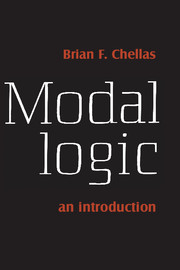4 - Normal systems of modal logic
Published online by Cambridge University Press: 05 June 2012
Summary
This chapter is devoted to studying, from a purely deductive standpoint, a class of systems of modal logic we call normal.
In section 4.1 we first define the class of normal systems. Then we derive a number of theorems and rules of inference common to all normal modal logics and use some of them to formulate alternative deductive characterizations of such systems. Theorems on replacement, negation, and duality are proved in section 4.2 for normal modal logics (they hold more generally for all classical systems, as we discover in chapter 8). These results provide rules and theorems that serve to facilitate derivations.
The smallest normal system of modal logic we call K. Thus every normal system of modal logic is a K-system. (The converse is false; not all K-systems are normal.) To simplify naming normal systems we write
KS1 … Sn
to denote the normal modal logic obtained by taking the schemas S1 …, Sn as theorems. In other words:
KS1 … Sn = the smallest normal system of modal logic containing (every instance of) the schemas S1 …, Sn.
So, for example, KT4 is the smallest normal system produced by treating the schemas T and 4 as theorems in a normal modal logic. (It is also denoted by K4T; the order of the schema names is irrelevant.) As the limiting case, where there are no schemas, the definition yields K as the smallest normal system.
- Type
- Chapter
- Information
- Modal LogicAn Introduction, pp. 113 - 161Publisher: Cambridge University PressPrint publication year: 1980



